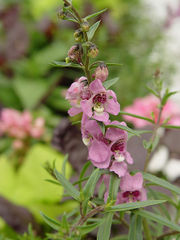Angelonia
| Angelonia subsp. var. | ||||||||||||||||||||||||||||||||||||||||||||||||||||||||
|---|---|---|---|---|---|---|---|---|---|---|---|---|---|---|---|---|---|---|---|---|---|---|---|---|---|---|---|---|---|---|---|---|---|---|---|---|---|---|---|---|---|---|---|---|---|---|---|---|---|---|---|---|---|---|---|---|

|
|
| ||||||||||||||||||||||||||||||||||||||||||||||||||||||
| ||||||||||||||||||||||||||||||||||||||||||||||||||||||||
Angelonia is a genus of about 30 species native to South America. Some species are cultivated as ornamental plants for their snapdragon-like flowers.
| Standard Cyclopedia of Horticulture |
|---|
|
Angelonia (South American name, angelón, of one of the species). Scrophulariaceae. Perennial herbs or sub-shrubs, grown in hothouses and conservatories, and in the open far South. Plants with the look of alonsoas: Lvs. simple, opposite (or alternate above): fls. showy, blue, irregularly 2-lipped, the upper lip 2-lobed and the lower larger and 3-lpbed; calyx 5-parted or 5-toothed; stamens 4, in pairs; ovary 2-celled. The axillary fls. are in a long, leafy terminal raceme: branches 4-sided.—About two dozen species from Mex. to Brazil. Grown as pot- plants in warm glasshouses and prop, by seeds or softwood cuttings.
|
Cultivation
Propagation
Pests and diseases
Varieties
Gallery
-
photo 1
-
photo 2
-
photo 3
References
- Standard Cyclopedia of Horticulture, by L. H. Bailey, MacMillan Co., 1963
External links
- w:Angelonia. Some of the material on this page may be from Wikipedia, under the Creative Commons license.
- Angelonia QR Code (Size 50, 100, 200, 500)
